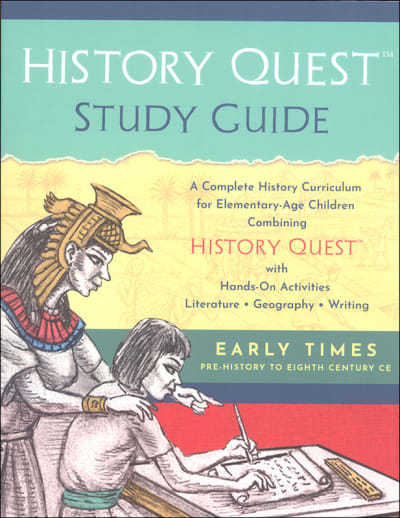This book contains the course materials for theHistory Quest™ Early Times, including a schedule, space for unit notes, and applicable answers. But the real course treasures are provided here, too: the students' mapwork, creative activity options (bas-relief sculpture or water-spitting gargoyle, anyone?) and pages for the history travel log-book (students record their weekly travels, as well as who they meet). Appendixes include map keys, a literature list, supply list, the Day 3 Create supply list, and student notebook pages. Each week follows this pattern: discover (read your History Quest), explore additional research, create, demonstrate learning (emphasizing key concepts through key terms, narration, and short answer), and enrich with additional websites and suggested reading. Perforated and reproducible for single family use.
History Quest: Early Times Study Guide
Description
History Quest: Early Times Study Guide contains everything you need for a full year's history curriculum for elementary-age children. Each weekly unit takes a chapter of History Quest: Early Times, the narrative history series, and turns it into a robust unit study with a week's worth of engaging activities. Your student will gain a broad and deep understanding of early civilizations through readings, geography activities, discussions, writing assignments, coloring pages, crafts, and more. Also included throughout the curriculum are four weeks of warm and cozy ancient literature study, where parents and students snuggle up together to enjoy time-honored tales from four ancient civilizations across the world. The History Quest: Early Times Study Guide is your child's first step in a lifelong quest to explore and appreciate history.
From Paleolithic times to the Islamic Empire, the Study Guide to History Quest: Early Times is a complete one-year curriculum guide that combines history with activities, world geography, great books, and writing. Young students study events and people from early civilization including ancient Egypt, Babylon, Assyria, Mesoamerica, Persia, Greece, India, Rome, Kush and Aksum, China, and Arabia. This comprehensive curriculum combines history studies with geography, literature, hands-on activities, and writing.
History Quest: Early Times Study Guide is a teacher/parent guide that provides step-by-step lessons to teach world history from Pre-history to the 8th century CE. This study guide includes: 31 weekly units with lessons, 13 ancient history blackline maps, hands-on activity instructions, literature and web link enrichment recommendations, unit schedules and supply lists, and student coloring and activity pages.
Learning techniques are woven throughout History Quest Study Guides at age-appropriate levels. Students examine multiple resources, read historically significant literature, develop and strengthen critical thinking skills, practice and refine written and verbal expression, and study world geography and geographical significances throughout the history of humankind.
Adaptable and personal, this history study takes a time travel approach from to Paleolithic times to the 8th century CE. Using the black & white illustrated text, activity-filled student guide and selected readers, your students will learn about the diversity of individuals, conflicts, ideas, inventions, and experiences that have shaped history.
Start with the 26-chapter narrative text, which highlights significant cultures and historical events, ranging from Paleolithic times (approx. 12,000 BCE) to the Byzantine and Arabian empires (700 AD). Each chapter ends with a section, "History Hop" which, using the 2nd person "you," transports your students to that specific time period to engage with people and events. Students will internalize this section by creating a Travel Log, which they'll add to a binder of their other written work and handmade projects: craft and art projects, cooking, coloring, map work, etc. Since religion has played a significant role in the shaping of culture and individuals, you'll find a neutral, instructional-based discussion of ancient religions when appropriate. Designed as a read-aloud specifically targeting grades 1-4, you'll want to preview topics and events with your particular students in mind. Note: the introduction refers to humans evolving from primates.
The Student Guide completes the course. Here you'll get weekly terms and concepts, supplies, resources, and enrichment ideas, and a schedule with directions: Day 1 (Discover-learn the topic); Day 2 (Explore-read History Hop, complete the Travel Log and more); Day 3 (Create-choose from a wide mix of projects); Day 4 (Demonstrate- complete assessment projects) and Day 5 (Enrich). The course also requires The Usborne Encyclopedia of World History with Internet Links. An additional 4 weeks will employ the Hyggia (pronounced HOO-guh) philosophy, emphasizing togetherness and wellbeing. For these units, the only assignment is reading an age-appropriate version of 4 myths: Gilgamesh, The Ramayana, and Greek and Chinese mythological stories. Appendix A provides map answer keys; appendix B lists all recommended activities. Appendix C pages include 13 maps, travel log sheets. Appendix C can be reproduced for family use. Internet access is integral to several of the suggested activities, such as accessing Google® Earth to view ancient cave pictures, and more. Text is 6"x 9", 516 pgs, pb. Study Guide is 8 1/2"x 11", 231+ pages, pb. ~ Ruth
| Product Format: | Paperback |
|---|---|
| Grades: | 1-6 |
| Brand: | Pandia Press |
| ISBN: | 9781733444101 |
| Length in Inches: | 11 |
| Width in Inches: | 8.5 |
| Height in Inches: | 0.5 |
| Weight in Pounds: | 1.65 |

